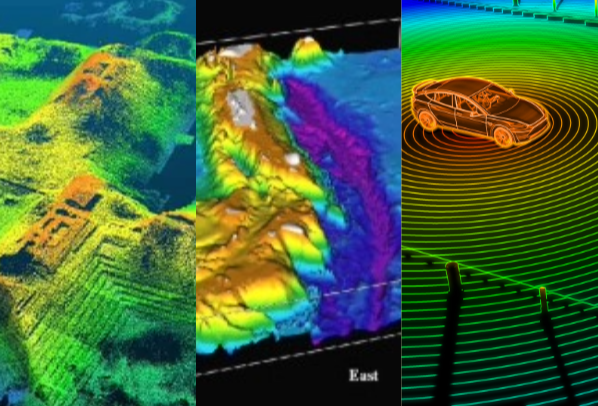
How LIDAR Systems Work
LIDAR (Light Detection and Ranging) systems rely on advanced LIDAR lasers to generate precise, three-dimensional maps of environments. These systems emit laser light to illuminate a target or scene, measuring the time or frequency of the reflected signals to a sensitive photodetector (receiver). By combining this data with information from other system components, LIDAR creates detailed representations of an area’s shape, surface characteristics, and spatial relationships. A typical LIDAR system comprises a laser source (transmitter), a high-sensitivity photodetector, synchronization and data processing electronics, and either motion-control mechanisms or solid-state microelectromechanical systems (MEMS) for precise laser scanning. For more details on laser technology, visit our updated Lasers 101 page, which covers advancements in solid-state and fiber lasers.
LIDAR Applications and Laser Specifications
LIDAR lasers are integral to diverse applications, including airborne topographic mapping, bathymetry, autonomous vehicle navigation, and coherent continuous-wave (CW) LIDAR systems. Each application demands specific laser wavelengths and performance characteristics tailored to the environment and objectives.
Airborne Topographic LIDAR
For airborne topographic mapping, LIDAR systems typically employ high-peak-power lasers with nanosecond pulses at wavelengths near 1 µm (e.g., 1064 nm, often from Nd:YAG lasers). These systems expand the beam to ensure eye safety while maintaining sufficient energy for long-range measurements, enabling detailed terrain mapping over large areas.
Bathymetry
Bathymetric LIDAR requires lasers optimized for underwater penetration. Frequency-doubled 532 nm lasers (green light) are commonly used, as this wavelength balances high transmission through water with minimal backscattering from suspended particulates. High-energy pulses ensure accurate mapping of seafloors and coastal regions, even in turbid conditions.
Autonomous Vehicles and Compact LIDAR
In autonomous vehicles and compact commercial LIDAR systems, eye-safe wavelengths are critical to ensure safety without compromising performance. Lasers operating around 1.5 µm (e.g., 1550 nm, often from pulsed erbium-doped fiber lasers) are preferred for detecting solid objects in topographic mapping and obstacle avoidance. This wavelength offers high atmospheric transparency and compatibility with efficient, low-cost detectors like InGaAs photodiodes, making it ideal for high-performance, compact systems.
Coherent Continuous-Wave (CW) LIDAR
Frequency-Modulated Continuous-Wave (FMCW) LIDAR, a type of coherent CW LIDAR, uses a CW fiber laser with a linearly chirped frequency to measure both distance and velocity simultaneously via Doppler shift detection. Operating typically at 1550 nm, FMCW LIDAR offers several advantages: high sensitivity for long-range detection (up to 300 m), immunity to interference from sunlight and other LIDAR systems, and robust performance in adverse weather like rain or fog. Key applications include:
- Autonomous Driving: FMCW LIDAR provides high-resolution 4D imaging (x, y, z, and velocity), enabling precise tracking of moving objects, such as vehicles and pedestrians, even in challenging conditions. Recent advancements, like silicon photonics integration, have reduced costs and enabled chip-scale systems for automotive use.
- Wind Energy: Coherent Doppler LIDARs at 1.5 µm measure wind speed and turbulence with high accuracy, optimizing wind turbine performance. Systems like ZephIR are widely deployed in the wind energy sector.
- Infrastructure Monitoring: FMCW LIDAR with wavelength-swept optical frequency combs enables long-range (over 1 km) and high-resolution (<1 mm) mapping of civil infrastructure, reducing the need for manual inspections.
Recent developments in FMCW LIDAR include silicon photonics platforms for compact, cost-effective systems and advanced modulation techniques, such as phase-coded subcarrier modulation, to mitigate Doppler-induced errors, enhancing applicability in dynamic environments like autonomous driving.
Considerations for LIDAR System Design
Designing LIDAR systems requires careful selection of laser specifications based on the application’s physical environment and performance goals. Key factors include:
- Wavelength: Determines penetration, safety, and detector compatibility.
- Pulse Duration and Energy (for pulsed systems) or Frequency Modulation (for CW systems): Affects range resolution, signal strength, and velocity measurement.
- Beam Quality and Scanning Mechanism: Influences spatial resolution and field of view.
As LIDAR technology evolves, advancements in laser sources, such as fiber lasers, diode-pumped solid-state lasers, and vertical-cavity surface-emitting lasers (VCSELs), continue to enhance system performance, enabling higher resolution, longer ranges, and greater reliability across applications.

 BUY NOW
BUY NOW